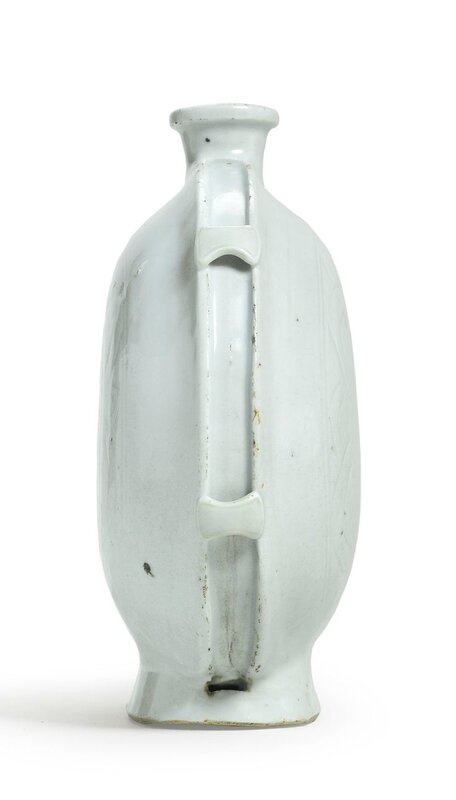A rare white-glazed pilgrim's flask, Yuan dynasty
A rare white-glazed pilgrim's flask, Yuan dynasty. Estimate 50,000 — 70,000 USD. Photo Sotheby's.
the flattened globular body, crisply channeled along the sides and set to each side set with a pair of lug handles, surmounted by a short neck and everted, lipped rim, all supported on a slightly splayed base, freely-carved with central medallions of a goose in flight grasping a reed in its beak, encircled by a row of overlapping petals all between double lines, glazed overall with a translucent pale bluish-green Qingbai glaze, settling to a deeper tone within the carved and potted recesses, the base and foot unglazed, Japanese wood box. Height 10 3/4 in., 27.3 cm
Notes: This very rare porcelain flask provides interesting evidence of the enduring influence of Near and Middle Eastern nomadic cultures on the Chinese aesthetic. Designed to contain water or oils, these vessels were formed with travel and long distances in mind. They were produced in a variety of different media; leather, glass, metal and ceramic. Near and Middle Eastern examples of flattened circular form date to as early as the second millennium BC. The earliest Chinese glazed pottery examples of flasks appeared during the Tang dynasty and retained their popularity with subsequent dynasties through the Qing. Whether or not the Chinese ceramic examples of the Tang through Yuan dynasties were meant to be actually used for travel remains debatable, Ming and Qing flasks, many produced by the imperial kilns at Jingdezhen, were created as luxurious exotically-derived objects to be admired.
The incised decoration on the present piece would seem to argue that it was more suitable for a scholar's studio than travel. The symbolic significance of wild geese, particularly geese in flight, took on specific meaning during the Yuan dynasty. Earlier Song dynasty depictions of geese focused on their reliability and orderliness as observed during predictable migratory patterns. However during the Yuan dynasty, the nomadic roots of the culture preferred to view the wild bird as a symbol of unhindered freedom, the ability to pursue one's dreams and was understood as a corollary to the life of the scholar whose imagination soared in search of inspiration. For further discussion on this iconography see Hou-mei Sung, Decoded Messages, The Symbolic Language of Chinese Animal Painting, Cincinnati Art Museum, 2009, pp. 61-80.
A yi with the same composition of a wild goose in flight holding a sprig but painted in underglaze red, from the George de Menasce collection, was included in the exhibition Mostra d’Arte Cinese/Exhibition of Chinese Art, Palazzo Ducale, Venice, 1954, cat. no. 594, and sold at Anderson Galleries, New York, 24th/25th January 1930, lot 383, and again in our London rooms 14th December 1976, lot 106. Another yi with the flying goose in white on a blue ground, formerly part of the Alfred Clark Collection and sold in our London rooms 24th March 1953 is illustrated in Sherman E. Lee and Wai Kam Ho, Chinese Art under the Mongols; The Yuan Dynasty, Cleveland Museum of Art, 1968, no. 158 and in the same publication isQingbai yuhuchunping with the same subject matter applied rather than incised onto the body, ibid, no. 112.
A flask of the same form and size from the Longquan kilns and dated to the Yuan dynasty is illustrated in Royal Ontario Museum: The T.T. Tsui Galleries of Chinese Art, Royal Ontario Museum, Toronto, 1996, no. 98. Another example of the same form and size but black and russet-glazed and with applied 'rope' decoration from the Schatzman Collection is illustrated inDark Jewels, Chinese Black and Brown Ceramics from the Schatzman Collection, Ackland Art Museum, 2002, no. 68 where the author suggests that during Yuan dynasty Mongolians appreciated the flask form as a reference to their nomadic roots and that the leather, metal and perhaps some ceramic versions were used to serve koumiss.
Sotheby's. Chinese Art through the Eye of Sakamoto Gor – Ceramics, New York, 17 mars 2015, 10:00 AM

/https%3A%2F%2Fprofilepics.canalblog.com%2Fprofilepics%2F1%2F0%2F100183.jpg)
/https%3A%2F%2Fstorage.canalblog.com%2F03%2F02%2F119589%2F96711876_o.jpg)
/https%3A%2F%2Fstorage.canalblog.com%2F11%2F31%2F119589%2F94773502_o.jpg)
/https%3A%2F%2Fstorage.canalblog.com%2F20%2F83%2F119589%2F94772815_o.jpg)
/https%3A%2F%2Fstorage.canalblog.com%2F26%2F72%2F119589%2F75604929_o.jpg)
/https%3A%2F%2Fstorage.canalblog.com%2F59%2F60%2F119589%2F26458628_o.jpg)





/image%2F1371349%2F20240418%2Fob_ac5c4c_telechargement.jpg)
/image%2F1371349%2F20240418%2Fob_709b64_304-1.jpg)
/image%2F1371349%2F20240418%2Fob_22f67e_303-1.jpg)
/http%3A%2F%2Fstorage.canalblog.com%2F56%2F38%2F119589%2F129865798_o.jpg)